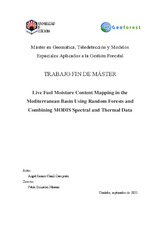Live Fuel Moisture Content Mapping in the Mediterranean Basin Using Random Forests and Combining MODIS Spectral and Thermal Data
Autor
Cunill Camprubí, Àngel Ramon
Tutor
González Moreno, PabloEditor
Universidad de CórdobaFecha
2023Materia
Live fuel moisture contentWildfire
MODIS
Spectral indices
Land surface temperature
Random Forests
Contenido de humedad del combustible vivo
Incendio forestal
Índice espectral
Temperatura superficial terrestre
METS:
Mostrar el registro METSPREMIS:
Mostrar el registro PREMISMetadatos
Mostrar el registro completo del ítemResumen
Remotely sensed vegetation indices have been widely used to estimate live fuel moisture content (LFMC), an important driver of wildfire risk, due to broad data availability. However, marked differences in vegetation structure affect the relationship between field-measured LFMC and reflectance, which limits spatial extrapolation of these indices. To overcome this limitation, I explored the potential of Random Forests (RF), a machine learning technique based on the ensemble of multiple decision trees, to estimate LFMC at the subcontinental scale in the Mediterranean basin wildland. I built RF models using a combination of MODIS spectral bands, vegetation indices, surface temperature, and the day of year as predictors. I used the Globe-LFMC and the Catalan LFMC monitoring program databases as ground-truth samples (10,374 samples). The modelling process consisted in a feature selection and two step spatial cross-validation in order to avoid spatial overfitting. The final LFMCRF model was calibrated and evaluated with samples collected between 2000 and 2014, and independently tested with samples from 2015 to 2019 reporting an overall root mean square errors (RMSE) of 19.9% and 16.4%, respectively. The results from LFMCRF were comparable to current approaches based on radiative transfer models (RMSE ~74–78%), introducing a reliable alternative for large-scale applications. This study fills an important research gap by creating a homogeneous approach to estimate LFMC across the Western Mediterranean basin. I used the final model to generate a public database with weekly LFMC maps extended to the fire-prone Mediterranean basin. Los índices de vegetación derivados de la teledetección se han utilizado ampliamente para estimar el contenido de humedad del combustible vivo (LFMC por sus siglas en inglés), un factor importante del riesgo de incendios forestales, debido a la amplia disponibilidad de datos. Sin embargo, marcadas diferencias en la estructura de la vegetación afectan la relación entre LFMC medido en campo y la reflectancia captada por los sensores de los satélites, lo que limita la extrapolación espacial de estos índices. Para superar esta limitación, exploré el potencial de Random Forests (RF), una técnica de aprendizaje automático basada en la agregación de múltiples árboles de decisión, para estimar LFMC a escala subcontinental en la cuenca Mediterránea. Probé distintos modelos de RF usando una combinación de bandas espectrales de MODIS, índices de vegetación, la temperatura superficial terrestre y el día del año como predictores. Utilicé las bases de datos del Globe-LFMC y del programa catalán de seguimiento de LFMC como muestras de verdad-terreno (10.374 muestras). El proceso de modelado consistió en una selección de predictores y una validación cruzada espacial para evitar el sobreajuste espacial. El modelo final de LFMCRF se calibró y evaluó con muestras recolectadas entre 2000 y 2014, y se probó de forma independiente con muestras de 2015 a 2019, reportando valores generales de raíz del error cuadrático medio (RMSE por sus siglas en inglés) de 19,9% y 16,4%, respectivamente. Los resultados de LFMCRF fueron comparables a los enfoques actuales basados en modelos de transferencia radiativa (RMSE ~74–78%), introduciendo una alternativa confiable para aplicaciones a gran escala. Este estudio llena un importante vacío de investigación al crear un enfoque homogéneo para estimar LFMC en toda el área occidental de la cuenca Mediterránea. El modelo final fue usado para generar una base de datos pública con mapas de LFMC semanales extendidos a toda la cuenca Mediterránea propensa a incendios forestales.
Descripción
Premio extraordinario de Trabajo Fin de Máster curso 2021/2022. Máster en Geomática, Teledetección y Modelos Espaciales Aplicados a la Gestión Forestal

